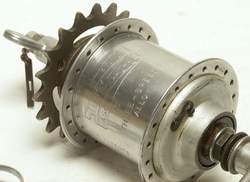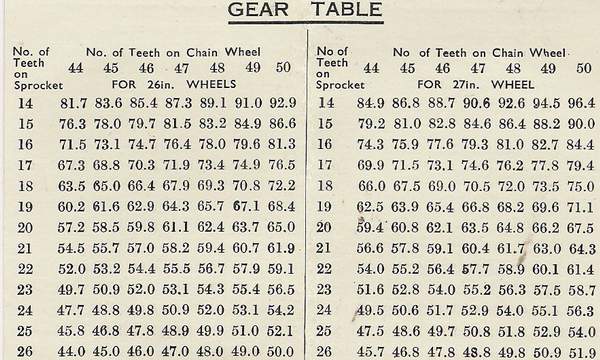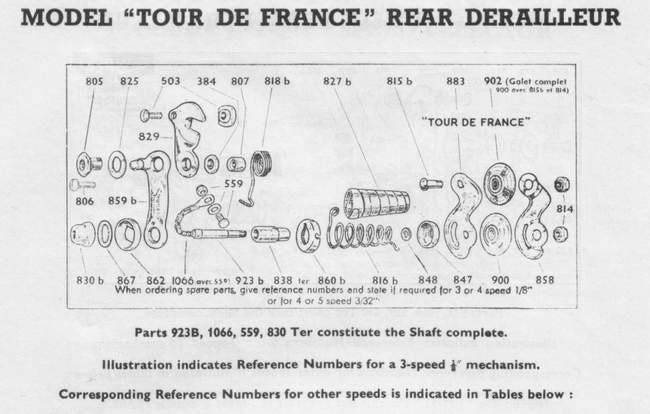Restoration - Sturmey Archer gears
Posted: Monday 21st September 2020
Let me point out straightaway that although I am a Sturmey user I have no idea what goes on inside that hub. Many people have tried to explain it to me and although I could describe the gear train within a car gearbox I have never got to grips with epicyclic gears. Having said that I hope that some of the following may be of use.
For starters here is a useful table to allow you to calculate the ratios on any of the more usual gears used by lightweight restorers:
AM – 3-speed medium ratio 15.55% increase, 13.46% decrease from normal
FM – 4-speed medium ratio 12.5% increase, 14.3% and 33.3% decrease from normal
ASC – 3-speed medium/close ratio fixed gear 10% & 25% decrease from direct drive
AC – 3-speed ultra close ratio 6.66% increase and 7.7% decrease from normal
FC – 4-speed close ratio 9.1% increase, 10% and 25% decrease from normal
FM, AC and FC internals are interchangeable
I think the AM is one of the sweetest and trouble-free gears to use but we have several FMs as they give you a useful ‘crawler’ gear if you suddenly come across a steep hill which you hadn’t expected. (See FM tip below).

I think the AM is one of the sweetest and trouble-free gears to use but we have several FMs as they give you a useful ‘crawler’ gear if you suddenly come across a steep hill which you hadn’t expected. (See FM tip below).
I have an ASC gear as well. I love riding fixed as it gives a great feel of being at one with the bike. With the ASC however there is a slight amount of slack in the gear itself which gets transferred to the cranks via the chain and gives perhaps one centimetre of slack at the crank end or pedal. The result is that it doesn’t really feel like a fixed at all so you get the worst of both worlds in a way. You can of course slow the machine by ‘reverse thrust’ of the legs but the slack between forward and reverse pressure on the pedals gives a different feel to a true fixed set-up.
The Sturmey ASC 3-speed fixed-wheel gear
with alloy shell, QR and wingnuts
The gear table below will help you to calculate your normal/direct drive gear. This is how the Brits do it but I think on the Continent they use a different formula:

Cyclists who rode in the 50’s always had one or two of these gears in their head, usually 48 x 16 = 81” gear and 48 x 18 = 72” gear. With these in mind they could get an approximation on the other ratios. The 48t chainwheel was used by many time-triallists with a 20t sprocket for winter training (64.8”), up to 18 in the early spring (when events were held which restricted the gear to 72”) and then up to 16 (81”) for the start of the season proper. Really fit riders would use 15t (86.4”)for 25 and 50 mile events but on the other hand the not-so-fit would use a 17t (76.2”) for events of 100 miles, 12-hours, or for the masochists, 24hours. The term ‘what are you on’ has a different connotation these days but in the 50’s the answer would be something like 64.8. Sorry I have drifted away from Sturmeys here.
Tourists will tell you that you can always use the 24” gear if it comes to it. 24” equals two feet and with two feet you can walk up any hill! Racers or pseudo racers like me on the other hand would rather risk a hernia than get off and push.

Sturmey Archer FM – Several people have told me that they have trouble with the Sturmey-Archer FM: they cannot get the bottom gear to lock in on steep hills – just when you need them of course. The secret seems to be to change the normal way into bottom gear, keep pulling on the trigger and start pedalling (spinning freely is no good, some pressure is needed) until you feel the trigger go click as it moves in just a little further. This seems to do the trick and it should hold now.
If, however, the first gear still slips then Bill Ives has sent the following hint:
I have been reading on the Classic Lightweights web site your bit about the difficulty of getting an SA four speed to go into bottom gear. Sometimes even if you can get it in it will jump straight out again. I have heard people say they have to hold the trigger to make sure the gear stays in.
The problem here is that the very high cable tension required means that the pawl which holds the quadrant in place is very likely to jump out and once it has done that a few times it becomes rounded off and so is more likely to jump out and become more worn. It’s a vicious circle.
Here’s a suggestion to fix it:- Remove the cable. Now take a sharp screwdriver and lever the side of the casing out, that’s the side that the cable ferrule screws/fits into. Lever it out just enough to remove the spring which will allow the pawl to pivot out. Using a bench grinder square up the end of the pawl. Don’t let it get too hot or the tempering will be damaged. The spring sometimes becomes a somewhat tired so give a little squeeze in the vice to tighten up the bend. Reassemble and tap the side back into place with a small hammer and with a bit of luck it will now stay in bottom gear.
There are instructions on repairing the FM including exploded diagram at:
http://www.hadland.me.uk/sa/safm.pdf
Yes, the point about the worn selector notch / weak spring syndrome on the four speed trigger is very relevant. My first new bike, 1956, had an FG hub, I rode this bike for many miles during my apprenticeship days, 21 mile round trip each day to the Ford works at Dagenham, and thereafter as a toolmaker until 1969 when I left the company. I can’t recall any problems with that one slipping out of “B” However, bikes in the present collection with four speed hubs have sometimes done this, and being an engineer and thus “going where others fear to tread “ sometimes, I have dismantled triggers and “fettled up” the pawl and lever notches. Taking the control apart has also the advantage that you can straighten the engraved fascia plate (which is often bent up) and this gets bonded to the lever housing on re-assembly to prevent damage re-occurring.
However, in fifty years of bike “mechanikin”and hub gear repairs in particular I have come across a few FM’s where the ratchet track on the LH ballcup has had a section break out, (part ref K 817 on Hadlands exploded view) and I’ve seen a case where one of the low gear pawls had burst through the alloy hub shell! I have an FM which had suffered a broken tooth and my approach was to replace the LH ball cup and the entire works with a FW internal (which has a similar low gear freewheel arrangement to the AW family hubs, and is thus fairly “bombproof”. Yes, I know the ratios are a bit wider, but the high gear is only about 26% increase compared with the 33% of the AW so the difference is not overly noticeable, at least not to a biker like me who’s used to Raleigh Lenton’s, 28″ Superbes and the like! The “dedicated ultra-lightweight fraternity” may well disagree!
The AM, I do agree, is an excellent hub. I have only come across one problem hub. This was brought to me by Mick Butler with a bent axle. Soon fixed with a replacement from Phoenix(Milton Keynes). I have an alloy-shelled example which one day will be utilised on a ’50s “lightweight”(which I have yet to acquire).
Sturmey lubrication: the best oil with which to lubricate a Sturmey hub is an oil produced for petrol lawn mowers known as 30W four-stroke motor mower engine oil. The domestic oils such as 3-in-1 are too thin and car engine oils are too thick.
Tony Hadland has written a book called The Sturmey-Archer Story which gives a technical overview of all things Sturmey. He has a website at http://www.hadland.me.uk
For more on Sturmey-Archer gears see the links under Components > Sturmey-Archer
Posted: Monday 21st September 2020
This article appears in the following categories.
Upcoming Events
Whether you are looking for a gentle social meet up, or a 100-mile ride browse the community’s upcoming events and plan your next weekend outing.
